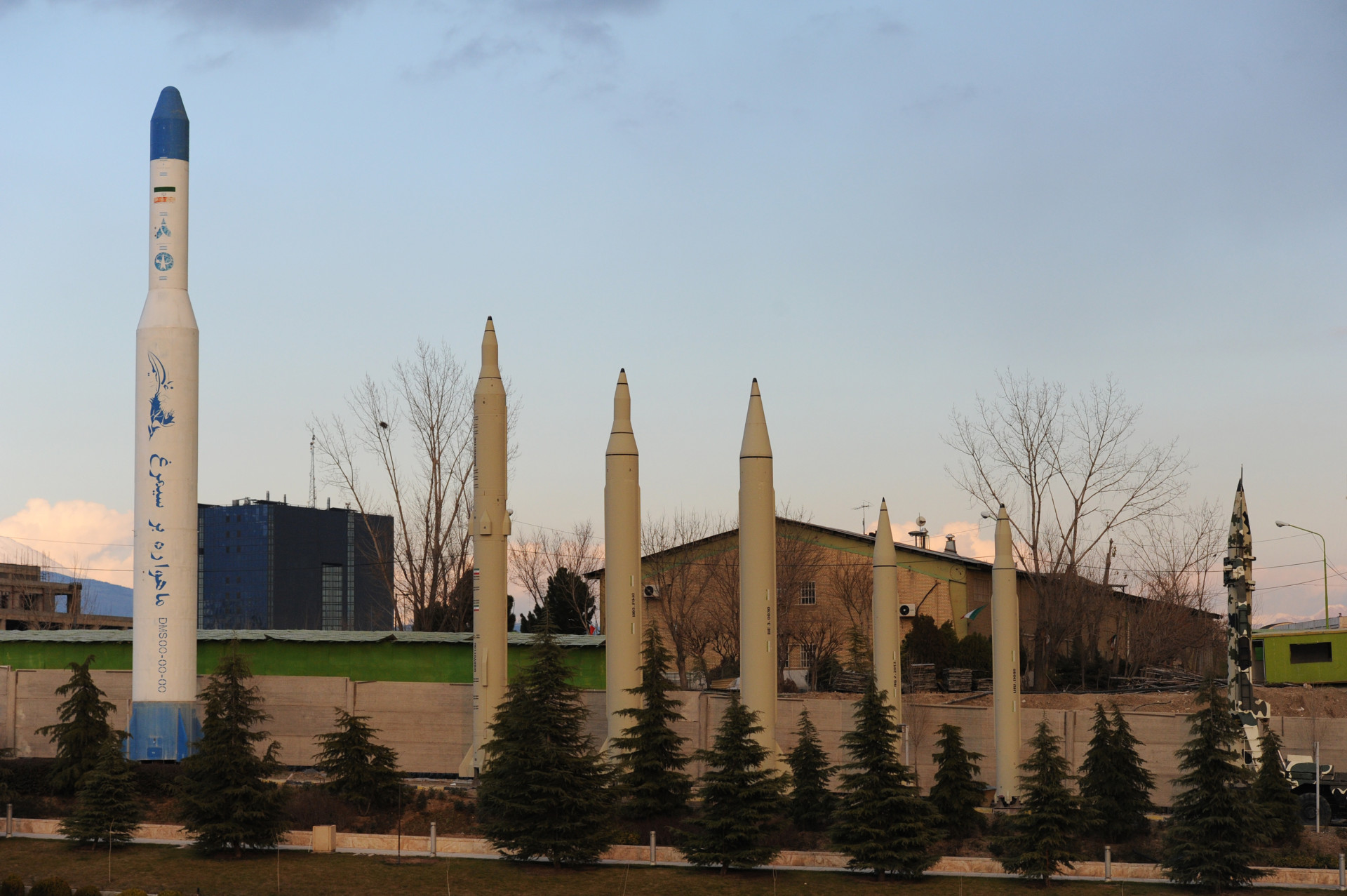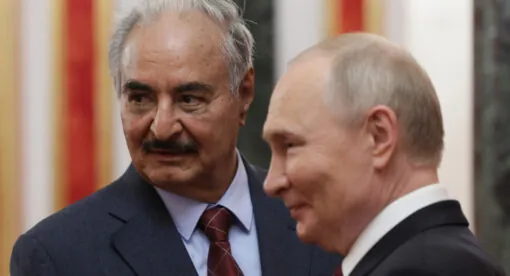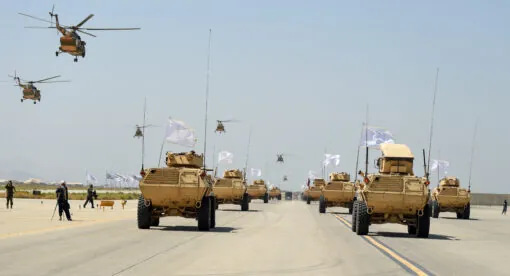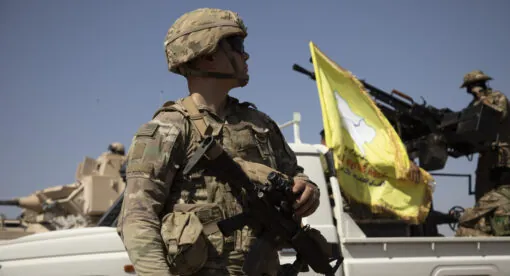Recently captured satellite imagery shows Iran’s efforts to produce bigger and better rockets that, because of their dual-use nature, could bring the Islamic Revolutionary Guard Corps closer to having intercontinental ballistic missiles.
Satellite imagery reveals that throughout 2021, Iran’s Islamic Revolutionary Guard Corps (IRGC) has been steadily expanding its facilities at Shahrud, the complex that is central to Iran’s military space program. The expansion suggests that the IRGC’s efforts to develop large-diameter, solid-fuel rockets are picking up speed. Because such rockets can be equally useful for space launch applications or for missiles, the accelerated effort could soon bring the IRGC closer to an intercontinental ballistic missile (ICBM) capability.
Even without nuclear weapons, an ability to strike Western Europe or the United States directly would dramatically shift the stakes of any potential military confrontation. This on its own might provide Iran with an additional level of deterrence, giving it greater freedom of action in pursuing its interests in the region. But such a capability would become an even more urgent issue if the Joint Comprehensive Plan of Action, the agreement that placed constraints on Iran’s nuclear program, collapses completely. That would raise the specter of Iranian nuclear and missile development programs advancing unconstrained, side-by-side.
Iran’s Two Space Efforts
Iran has two space-related efforts. The first is the pseudo-civilian program run by the Iranian Space Agency (ISA), which is part of the Ministry of Information and Communications Technology. The ISA could be fairly characterized as something of an ersatz NASA, and it plans to eventually put humans into space. But, for now, the program is focused on the more modest goal of putting satellites into orbit by means of carrier rockets, often called space-launch vehicles.
It is these rockets that give the ISA effort something of a military dimension and make it a valuable case study on a how civilian program can become the target of international sanctions and export controls. All of the ISA’s space-launch vehicles are designed and produced by the Aerospace Industries Organization and its sub-groups, the same institutions responsible for building Iran’s missiles. Moreover, up until very recently, Iran had employed just two space-launch vehicle designs, the Safir and the Simorgh, and both are adapted from Iran’s Shahab-3 missile. The Safir is essentially an elongated version of the Shahab-3 with a small second stage on top, and the larger Simorgh uses a cluster of four Shahab-3 engines for its first stage.
This institutional overlap, compounded by the fact that rocket boosters are inherently a dual-use technology, has led some experts and numerous U.S. officials to claim that Iran’s space-launch program is nothing more than a cover for ICBM development work. But for the Safir and Simorgh this concern is overblown. Both systems are large, cumbersome, require hours or even days to fuel up and prepare for launch, and would be an easy target for a pre-launch counterattack. Because of such features, those space-launch vehicles could never really satisfy the rigorous operational requirements to be valuable as a weapon, and serious missile experts refuted the idea that the Safir or Simorgh represented a credible path to an ICBM.
Beyond the ISA’s space program, there is a second space effort directed by the IRGC’s Research and Self-Sufficiency Jihad Organization. The origins of this program, initially called Project Ghaem, are difficult to piece together, but it likely began in the late 2000s and carried on its work at an IRGC base located on the western outskirts of Tehran called Shahid Modarres Garrison. The man in charge was Hassan Tehrani Moghaddam, considered by many to be the father of Iran’s missile program.
Unlike the ISA effort, the IRGC program was established as a hedging strategy to advance work on long-range, solid-fuel missile technology. In 2014, the deputy commander of the IRGC’s Aerospace Forces Majid Musavi admitted as much when he stated that Moghaddam had begun working on space-launch vehicles following Supreme Leader Ayatollah Ali Khamenei’s decision to set a unilateral range limit of 2,000 kilometers (1,242 miles) for all of Iran’s missiles. Moghaddam, Musavi said, did this because he wanted to continue making progress in the field of solid-fuel rocket technology. More directly, Moghaddam’s own brother claimed in an interview in 2011 that Moghaddam had been conducting work directly related to an ICBM.
Solid-fuel rockets have several operational advantages over their liquid-fueled brethren, and these heighten the dual-use risks. They are safer and easier to operate, have shorter launch preparation times, and generally have a lower signature since they do not require as large a convoy of support and fueling vehicles to accompany them. Beyond this, in the specific case of Iran, there’s another reason. Iranian engineers have squeezed about as much potential out of the liquid-fueled rockets as possible. For the Safir and Simorgh, there is very little else they can do to reach higher altitudes (or, in the case of a missile, longer ranges) without replacing the current engine with a better one, which would mean an entirely new system. On the solid-fuel side, however, once Iranian engineers master large-diameter solid-propellant motors, reaching longer and longer ranges becomes feasible.
Clearing that technical hurdle is much easier said than done. Moghaddam and his colleagues were apparently close to doing so in 2011 when an explosion – it’s unclear if it was an accident or sabotage – killed Moghaddam and 38 of his colleagues. Given the loss of human capital as well as the destruction of much of the facility itself, it was plausible to assume that the IRGC program might have gone away entirely. But in 2018, researchers at the Middlebury Institute of International Studies at Monterey discovered that, before his death, Moghaddam had overseen the development of a new facility for his project, located at Shahrud, and that the program likely lived on. Shahrud had been the site of Iran’s first test of the Shahab-3 in 1998, and was on many analysts’ radars following a 2013 report in Jane’s Intelligence Review noting the construction of a new launch pad and other facilities, visible in satellite imagery. But no one had quite connected it to Moghaddam’s space program.
The launch of the Qased rocket on April 22, 2020, made clear that, although it may have gone dormant for a time, the IRGC program was carrying on. More than that, though, the launch was a sign of things to come. A few days later, the commander of the IRGC’s Aerospace Forces Amir Ali Hajizadeh went for an interview on Iranian state television and explained that the launch had been designed to test the rocket’s second and third stages, including the IRGC’s new, advanced Salman motor. For that reason, engineers relied on proven technology for the first stage, using an adapted liquid-fueled missile (Ghadr) for the purpose. Future launches, he said, would use rockets with only solid propellants. Recent developments at Shahrud suggest that work is underway to make that goal a reality.
New Developments at Shahrud
The sprawling complex at Shahrud, central to the IRGC’s solid-fuel space-launch and missile development activities, has undergone a comprehensive expansion over the course of 2021, portending an increase in more overt space launch and missile activities in the coming years. Recently, there has been activity at five areas in the complex: the administrative support area, the storage area, the solid propellant production area, the test stand area, and the launch pad.

On the northwestern end of the complex is Shahrud’s main entry point, which includes buildings that are likely associated with administrative support, as well as a mosque. Satellite imagery provided by Maxar Technologies reveals that construction for a new building in this area, measuring about 40 meters long and 30 meters wide, began in January 2021 and was completed before early July. Additionally, imagery from April 3 shows a possible trench extending in a southeast direction from one of the buildings, though by July this appears to have been covered. Similarly, the image from July shows another possible trench extending from a building to the northeast, along with grading for a new road extending in a parallel direction.
About 1.5 kilometers to the southeast of the administrative area is likely the main production area for solid-propellant rocket motors, given the visible safety measures in place. These include large earthen berms that surround several of the buildings, providing a modicum of protection to other buildings in the event of an accidental explosion, as well as lightning arrestors. Already, as of 2020, this area consisted of some 23 buildings, the tallest of which is at least five stories high and, given that it sits next to an apparent casting pit, may be used for assembling multi-stage rockets.

Over the first eight months of 2021, construction was underway on at least seven new buildings in this area. The largest of these is a 60-meter-by-50-meter structure with a curved roof, resembling a large aircraft hangar, but whose exact purpose is unclear. Another of the new buildings is about 32 meters in length and is similar in form to three adjacent, preexisting structures. All appear to be drive-through garages for vehicles that would transport assembled rockets or missiles.
Nearby, foundation work has begun on seven structures that, based on their layout pattern, could be additional storage either for transport vehicles or explosives.

Around mid-March, a large burn scar appeared in the rocket motor test stand area. This was the first time Iranian engineers had made use of this test stand, the largest of the four in the area, indicating that they have reached a milestone in terms of the size of the motors. Additionally, a report in Jane’s noted that another rocket motor test on a different test stand was likely conducted in mid-July.

The launch pad has also been the site of activity during 2021, although there do not appear to have been any launches. Rather, the moveable gantry tower that normally sits on the eastern side of the launch pad was moved to the middle sometime between Jan. 10 and Feb. 24. It apparently remained there for several months, until it was moved back to the eastern side sometime between May 30 and July 7. The gantry tower also apparently spent much of the latter half of 2020 in the center position. Generally, a gantry tower would be employed in the case of a launch, but since in this case no launch appears to have occurred, the reason for its changed position is unclear.
Implications
These developments point to the conclusion that the IRGC will continue ramping up its effort to produce large-diameter, solid-propellant motors, and it would be no surprise to see the flight testing of a rocket that would be useful in both space-launch and missile applications in the near future.
Of course, Iran has already demonstrated a significant breakthrough in solid-propellant rocket technology with the February 2021 reveal of the Zoljanah, a space-launch vehicle employed by the ISA. With a 1.5-meter diameter first stage, the Zoljanah was the largest solid-fuel rocket motor Iran had ever flight tested, and if it had been flown on a ballistic trajectory, it may have reached 5,000 kilometers. Moreover, it was launched from a mobile launcher. In other words, even though it is apparently owned by the civilian space program, the Zoljanah carries with it many if not all of the dual-use risks that would be associated with an IRGC solid-fuel space-launch rocket.
But despite the ISA’s launch of the Zoljanah, the IRGC has still yet to deliver on its own promise of an all-solid-propellant space-launch vehicle, raising the prospect of two separate entities in Iran with that technological capability in the near future.
Currently, Iran does not have any deployed missiles in its arsenal that could reach Western Europe, let alone the United States, but if Iranian engineers can master solid-propellant rocket technologies for space-launch applications, it would give Iran a latent ICBM capability. It also comes at a time when U.S. policymakers have been repeatedly caught off guard by significant developments in other countries’ missile capabilities, such as North Korea’s recent long-range cruise missile test or unconfirmed reports of China’s test of a nuclear-capable Earth-orbiting missile. Accordingly, U.S. policymakers would benefit from greater vigilance and attention to the Iranian missile problem now, while it is still possible to prevent an Iranian ICBM capability.
For years, non-governmental experts and some officials have talked about trying to negotiate a cap on Iranian missile ranges, locking in the country’s self-imposed 2,000-kilometer range limit. But that proposal was predicated on two considerations. First, it was made before Iran had any dependable system that could reach beyond 2,000-kilometer ranges. And second, it assumed that Iran would continue to rely on the Safir, Simorgh, and related liquid-fueled systems for space launches, keeping the dual-use risks manageable. What happens when those considerations no longer hold true?
It is only recently that policymakers have started to take the issue seriously, particularly in the context of negotiations to restore the Joint Comprehensive Plan of Action (JCPOA), the 2015 nuclear agreement with Iran. Press reports indicate that, during talks in Vienna earlier in the year, U.S. and European officials had pushed for Iran to commit in writing to participate in follow-on talks that would address Iran’s missiles and its support for proxy groups. Indeed, this was one of the main sticking points of the Vienna talks, which have been on hiatus since June 20.
If the West ends up dropping the demand to address Iranian missiles as a condition to restore the JCPOA, there is no clear backup plan for bringing Iran to the table on this topic, or on the topic of Iran’s regional posture and support for proxy groups. Plus, with the new government in Iran dragging its feet on returning to Vienna – and floating new, fanciful trial balloons that could be interpreted as preconditions just for returning to the table – it is possible that the JCPOA will not be restored at all.
What is needed is more serious debate among policymakers in the United States as well as among allies and partners in Europe and the Middle East about how to bring Iran to the table to discuss missile-related issues, what the appropriate forum for such a diplomatic process would be, who would lead it, what outcomes it might realistically hope to achieve, and how the dual-use risks of Iran’s space-launch programs might be managed. A negotiated 2,000-kilometer range limit may soon no longer be a feasible objective, if it ever was.
John Krzyzaniak is a Research Analyst for the Non-Proliferation and Nuclear Policy Program, where he focuses on Iran and North Korea. Iran’s nuclear and missile programs, North Korea’s nuclear and missile programs, and arms control. Before joining the Institute, John was an editor at the Bulletin of the Atomic Scientists. He holds a master’s degree in International Affairs from the Georgia Institute of Technology. He tweets at @john_krzyzaniak.






